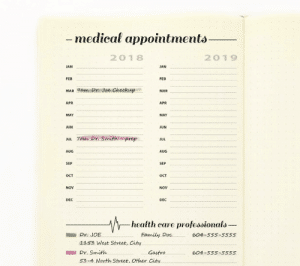
Track Your Digestive Health
Read the article to learn more, then download our free printable templates to get started!
Available in full-page or half-page sizes.
Do you maintain a journal for digestive health? By recording your experiences on a particular day – such as what you ate, how much water you drank, or the state of your mental health – you might begin to understand what aspects of your life affect your symptoms and be able to make changes accordingly. Health journals may help you track the long-term effects of your diet and lifestyle – the patterns of your health – so that you can make future choices that contribute to better digestive health.
For example, say that one day you find yourself unusually constipated. How do you know what caused the change? And, if it keeps happening, how might you prevent it in the future? If you aren’t journaling, then you have to rely on memory to know what you ate, whether you drank enough water, remembered to take your medication, had consumed something out of the ordinary in the past week, skipped yoga class, started taking a new vitamin, and other such things over the past few days. This is where a journal can help. If you have a record to look back through, you might notice that in the days leading up to the constipation, you didn’t eat enough fibre or drink enough water. Based on your observations, you could try to adjust your habits, thereby reducing or avoiding the symptom.
We do want to offer a bit of a disclaimer, with digestive illness, sometimes there are no obvious answers, your symptoms may be unrelated to your diet and lifestyle choices or the answers may be unobservable. However, we hope it can help in some way – provided you use and interpret the information you gather – to at least get a better understanding of what lifestyle factors positively or negatively affect your digestive symptoms. We do not intend to replace the knowledge or diagnosis of your health care providers and we always encourage you to contact them before making changes to your diet or lifestyle.
In this article, we focus on a specific, newer style of journaling: bullet journaling. However, other types of journaling can also benefit from some of these tips. So, if you already have a digestive health journal, or are interested in starting one, we hope this information helps you help yourself to a healthier digestive tract – gum to bum.
What is a Bullet Style Journal?
If you love using Pinterest, stationery, or journaling, you may already have come across the bullet style journal. For the rest of you, in its simplest form, a bullet journal uses points or ‘bullets’ for recording actionable items. According to its creator, the bullet journal is an ‘analog solution to a digital life’. Bullet journals use a system that is highly adaptable and allows your creativity to flow unconstrained by the formula set by regular scheduling-based journals. They are budget friendly – any notebook can work – although the bullet journaling world tends to focus on a few specific brands such as the LEUCHTTURM1917 and Molskine notebooks. They can be as customized to your own style and time commitment, which is probably why this technique is so popular. The bullet style journal is a planner, a diary, and a to-do list all in one, and all you need is some paper and a pen.

Bullet Journal Basics
Ryder Carroll created the official Bullet Journal® (or BuJo® for short) in 2013. Bullet journaling involves writing out a list of tasks you want to complete that day, week, month, or year. You then use a series of symbols to show whether each item is something you still need to do, something you already completed, or something you want to put off for later. This method is referred to as rapid logging. You indicate notes and events with a different mark, as well as secondary symbols to prioritize some bullets. Most people find it helpful to include a key until they become more familiar with the style. Bullet journals usually include an index in the first few pages to make it easier to locate the different schedules, notes, or collections in the rest of the journal.
Collections
Since bullet journals aren’t traditionally structured, at any point you can insert a collection or module to focus on a particular subject. Use collections to track simple daily tasks, such as taking your medication, or specific events, such as doctor appointments. While we are mostly focusing on aspects relevant to GI diseases and disorders, this works great for everything you want to manage in your life, such as birthdays, chores, errands, and anything else for which you could use a reminder.
We’ve created some examples of collections we think can help. The images will give you a visual guide of how these work, and the text will explain more ways you can use these.
![]()
Habit Tracker
You can use this to track anything simple over a long period of time. Typically, the topics would be something you could answer either ‘yes’ or ‘no’ to. It can include recording whether you experienced certain symptoms, such as constipation, bloating, diarrhea, heartburn, and/or pain each day. It is also useful to see at a glance which days you did or did not take your medications and any supplements you need. You can also rate any of these items on a scale of one to ten, and enter the number into the small square. For example, you could write in that you got seven hours of sleep the previous night.
Diet related goals work well in the habit tracker, because it is easy to see accurately just how well you are sticking to them. For instance, you might want to make note of each day that you drank eight cups of water, or ate six or more servings of fruits and vegetables. Alternatively, you might be trying to avoid caffeine or alcohol, and you could list days that you didn’t consume either of these. You can also fill in squares to show when you were menstruating, as this can have an effect on symptoms in some diseases and disorders. Bullet journaling is great for keeping track of exercise. You can record it generally as ‘I exercised today’ or you can be more specific and have lines for your favourite types of exercise, for example you might have yoga, jogging, and lifting weights each on its own row.

Daily Log
You may prefer a more detailed method of tracking your digestive health, and daily logs are the best way to get into the nitty gritty of each day. Catalogue items such as your schedule, the food you ate, any symptoms you experienced, all the exercise you completed, and other aspects specific to your condition. You can start by recording what time you went to bed the night before and when you woke up, and include any other information that you want to make sure you remember to do, or that you think will be important information to have in the case of a flare-up. This is also the perfect way to try to identify which foods cause or worsen symptoms for you. In this section, you can write down all the supplements and/or medications you need/choose to take, and then tick the checkbox once you have taken them.
It is also helpful to write down your moods during the day, as well as how much pain you are in, and depending on which GI disease or disorder you have, marking down your bowel movements, such as how many times you went, and what they ranked on the Bristol Stool Chart. Other items you may find useful to track in your bullet journal:
- your diagnosis
- viral or bacteria infections
- medication or food allergies
- pain level
- exercise and exercise related supplements/drinks
- hormones, especially menstrual cycle fluctuations
- sleep quantity and quality
- skin changes
Future Log
With the future log, you can have all the big events for the upcoming year visible in one place. This is where you record everything you want to remember, such as birthdays, parties, family gatherings, work events, social events, vacations, travel, and anything else that is important. There are several ways you can lay out your future log, but they all involve keeping a year’s worth of events in one or two pages, using short descriptions of each event.

Appointments
A variation on a future log, this layout makes it easy to manage all your upcoming medical appointments on one page. First, fill in the lines with the contact details for all your health care professionals, such as your family doctor, gastroenterologist, registered dietitian, psychologist/psychiatrist, naturopath, or any others with whom you regularly have appointments. Then, give each medical professional/medical office a colour. On the line for each month, enter the date of the scheduled appointment in the colour you chose for that specific type of appointment. You can use a similar layout for other events, such as birthdays, parties, or work events.
Talking to Your Health Care Provider
Most health care providers will not have time during your appointment to look through your journal, so prepare in advance by marking all the important observations, serious symptoms, or overarching patterns you’ve recorded. Make sure you keep your health care team informed on any drugs, vitamins, supplements, naturopathic treatments, or Traditional Chinese Medicines that you take. Explain in simple terms what information you’ve gathered from journaling about your health and ask them about your theories. Always let your physician know if you develop any new symptoms. If you think you need help designing a diet that is ideal for you, then contact Dietitians of Canada at www.dietitians.ca.
Using the Information
Be sure to discuss any dietary or lifestyle modifications with your physician or other health care provider before implementing them yourself. Monitor your diet in correlation to Canada’s Food Guide.
Bullet journaling can be as simple or as elaborate as you want it to be – don’t get stressed or overwhelmed if your journal doesn’t look as artistic as the examples you can find online. Make your bullet journal work for you, keep it simple if that’s what works best for your lifestyle. Remember, you can’t get value from information you don’t collect. Take your health seriously, because you are your best advocate on the road to improved digestive health!
Printed Version
In early 2020, we created a digestive health journal (with three different covers) that you can use to track your diet and lifestyle. Learn more here.
First published in the Inside Tract® newsletter issue 204 – 2017


